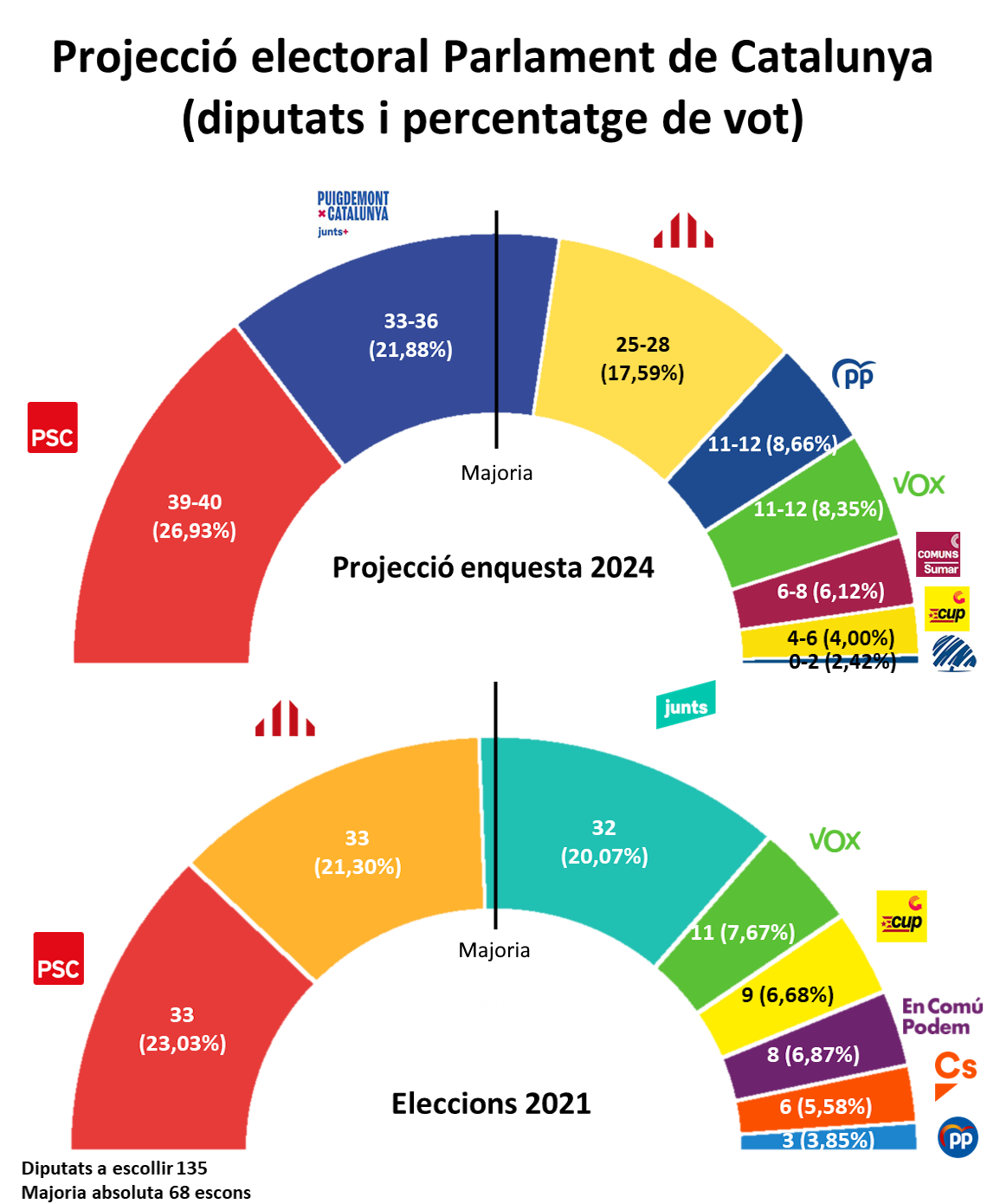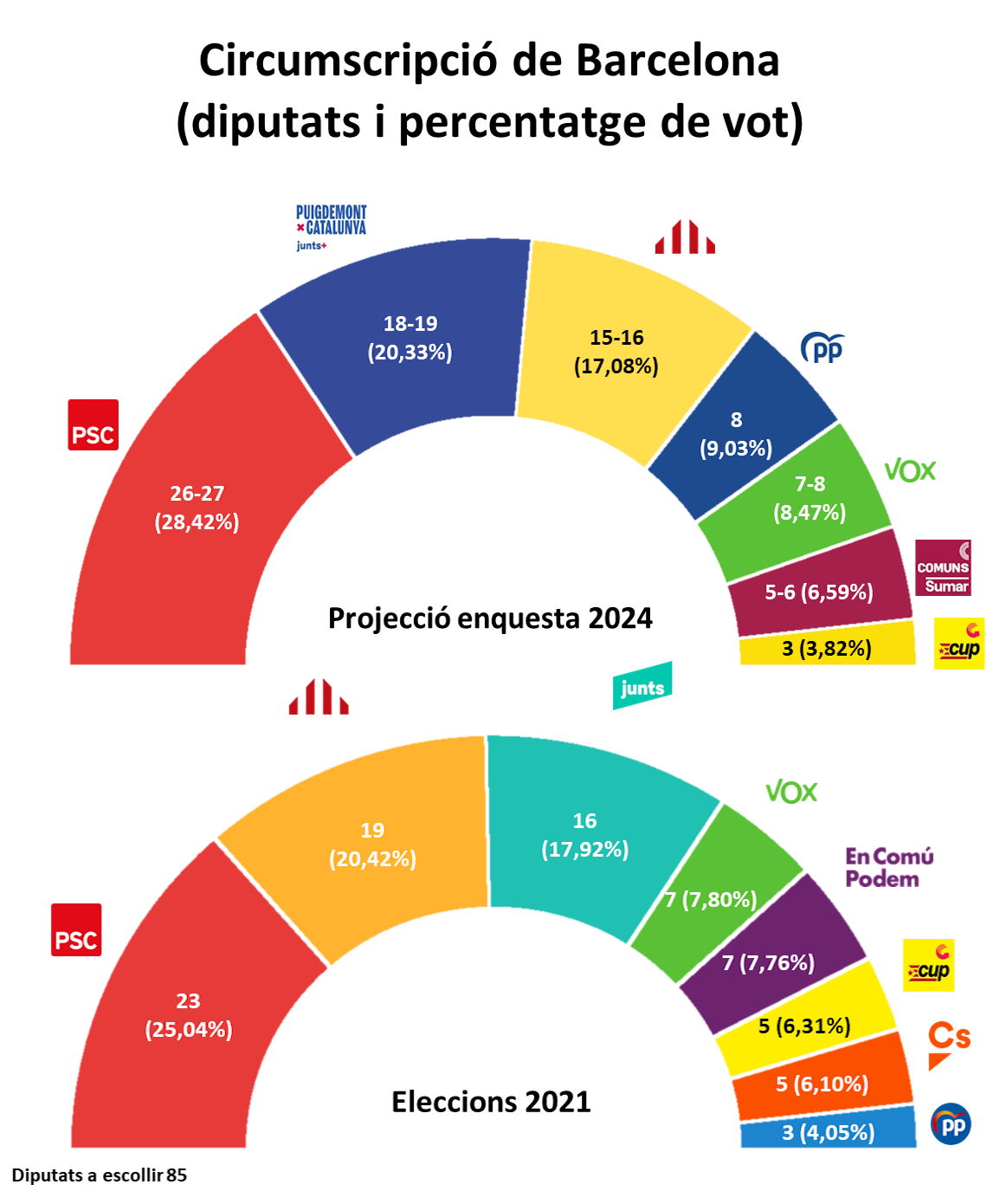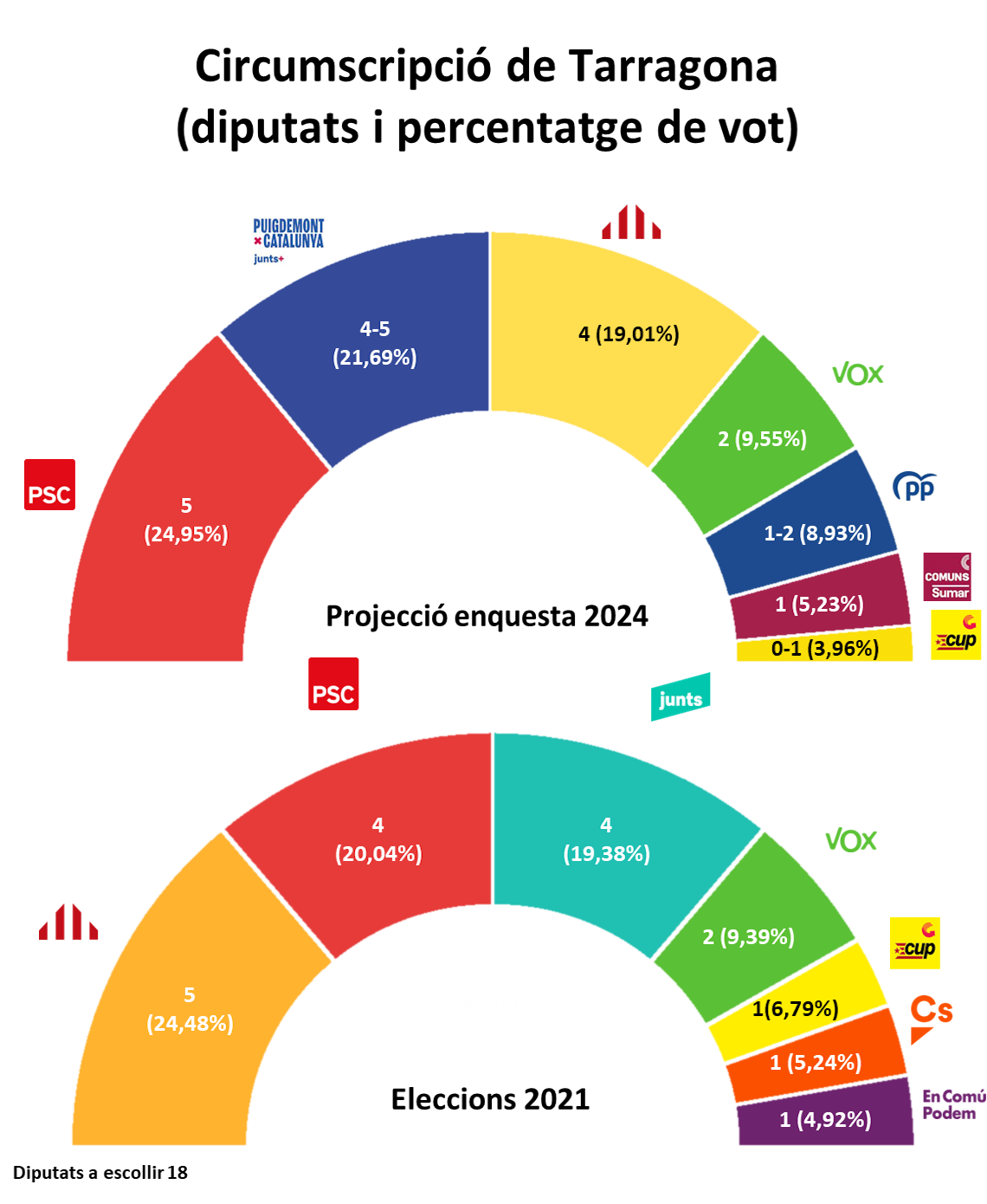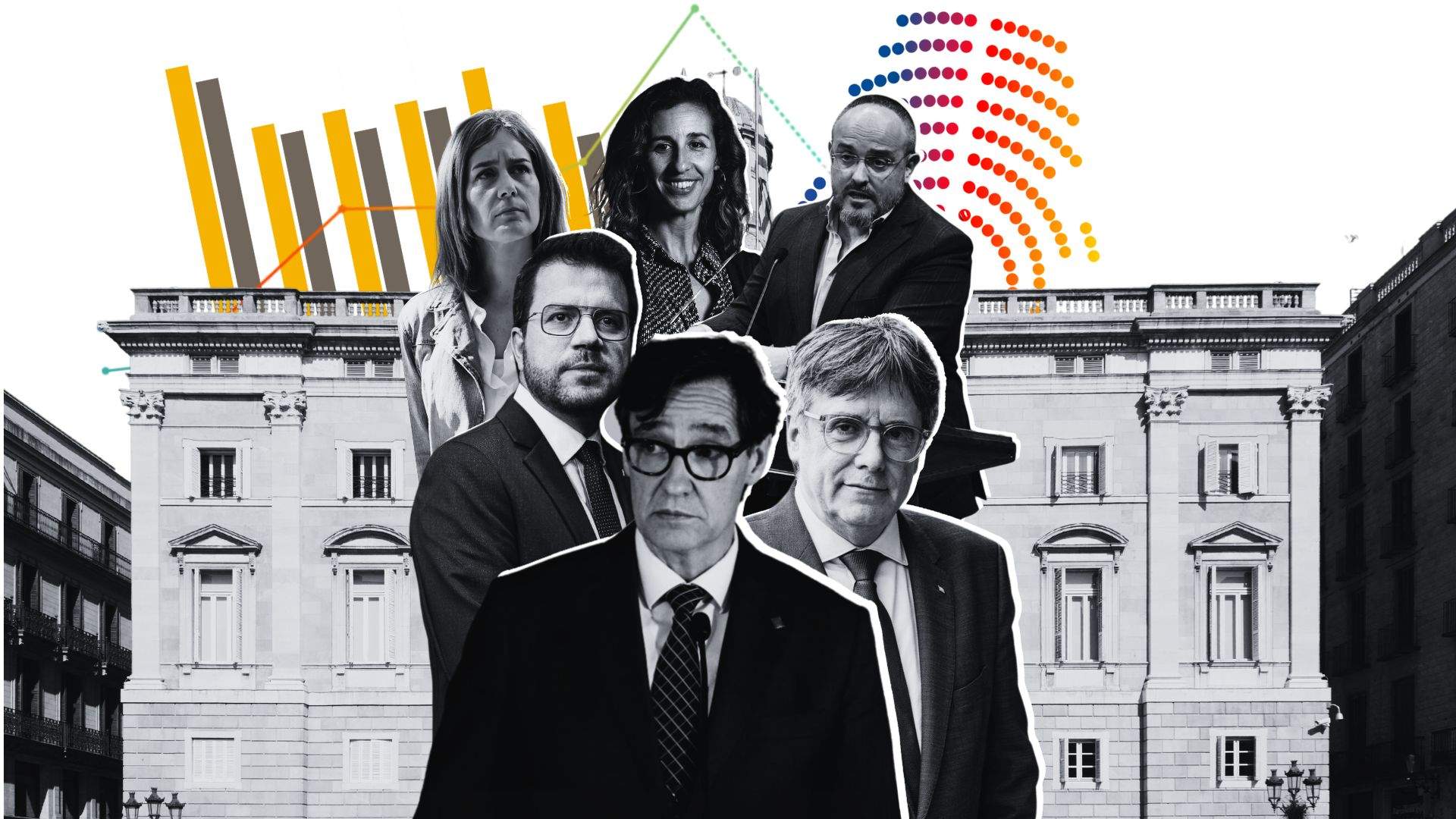It ain't over yet. The final stretch of the Catalan election campaign will be decisive. The Catalan Socialist Party (PSC) of Salvador Illa is expected to win the May 12th election to the Catalan Parliament, but Junts+ Puigdemont for Catalonia, the candidacy of the Catalan president in exile, is gaining momentum and has begun to cut into the Socialists' lead. The Catalan Republican Left (ERC) is forecast to finish as third largest party in the future Parliament. These are the results of the latest survey commissioned by ElNacional.cat from the Feedback Institute, directed by Jordi Sauret, on the last day that vote projection studies can be legally published. The survey is based on a tracking poll of 800 telephone interviews, which was completed this Monday, May 6th. The survey predicts a turnout of 56.7% and detects 31.1% of potential voters who are still undecided.

According to the survey, the PSC would obtain 39-40 MPs in the new Parliament of Catalonia, that is to say, it would increase its current total by 6 to 7, with 26.93% of the vote. The so-called Sánchez effect has consolidated Illa at the top of the table, although he has difficulties to break through the ceiling of 40 parliamentary deputies. The PSC was the winner of the 2021 elections with 33 seats, although it was unable to form a government against the pro-independence majority.
On the other hand, Junts's candidacy would improve on recent forecasts: this survey, six days before the election, gives the party 33-36 seats, between 1 and 5 more than in the 2021 elections (32), and 21.88% of the vote. This leaves Puigdemont's four deputies short of the Socialist total in the best scenario predicted by the survey for both parties. Junts make progress in all four Catalan demarcations in this poll. In the previous Feedback poll, published last Saturday by ElNacional.cat, Junts+ Puigdemont for Catalonia were 7 deputies below the PSC.
In third place would be ERC, led by the current Catalan president, Pere Aragonès, with 25-28 deputies and 17.59% of the vote, taking quite a battering: in 2001 the party tied for second place in deputies with the PSC (32).
The fourth largest party would be the People's Party (PP) of Alejandro Fernández, which, having won only 3 deputies in the previous Catalan elections, would now go on to obtain between 11 and 12 and 8.66% of the vote. However, Vox, the far-right party headed by Ignacio Garriga, would achieve a technical tie with the PP, with 11-12 seats - the same or 1 more than in 2021 - and 8.35% of the vote.
Left-wing Comuns-Sumar under Jéssica Albiach are expected to regain ground in relation to the previous Feedback polls, and would obtain between 6 and 8 deputies - they could lose 2 or even keep all of their current 8 - and 6.12% of the total vote. The pro-independence leftists CUP, on the other hand, would fall back, with 4-6 deputies and 4% of the vote: from 5 to 3 less than in the 2021 elections. The Islamophobic party Aliança Catalana (AC) obtains a forecast of 0-2 seats and a 2 .42% of the vote.
The pro-independence party Alhora, of Jordi Graupera and Clara Ponsatí, would not enter Parliament (0 seats and 0.95% of votes). Neither would Ciudadanos (Cs), which are expected to lose the 6 seats they retained in 2021. Carlos Carrizosa would collect a minuscule 0.89% of the vote.
Scenarios for forming a government
The results of this last legal poll on Sunday's Catalan election leave open the scenarios for agreements between parties to invest the next president of the Generalitat of Catalonia, and thus form a government. Illa's most viable option to form a government majority would be a left-wing tripartite between the PSC, ERC and Comuns-Sumar, which would have a total of 70 to 76 deputies, from 2 to 8 MPs more than the 68 needed for an absolute majority.
As for Puigdemont, the president in exile could aspire to lead a new pro-independence alliance, but only in the best scenario of the projection for Junts, ERC and the CUP, with a margin of between 62 and 70 seats. Otherwise, Illa would need Vox's participation in order to attempt an investiture in the style of Jaume Collboni in Barcelona - working with the PP to remove the pro-independence parties from power.
Barcelona
Looking at the four Catalan macro-electorates one by one, the PSC comes first in Barcelona and Tarragona, where it displaces ERC, while Junts+ Puigdemont for Catalonia consolidates its first place in Girona and Lleida. Junts reduces the distances with the Socialists in all constituencies.
In Barcelona, the PSC records its most notable growth with 26-27 seats (it won 23 in 2021). Junts displaces ERC as the second-ranked party with 18-19 deputies (16 in 2021). ERC would be third with a margin of 15-16 seats (19 in the previous elections). The PP would have the most spectacular increase, going from 3 to 8 seats. It is closely followed by Vox, with 7-8 seats (either one more or the same as it had). The Comuns would drop from 7 to 5-6; the CUP, from 5 to 3 and Cs would lose all of the 5 it previously held.
The Feedback poll assigns the last seat for Barcelona to the PP. However, this seat would also be disputed, in order of probability, by Comuns-Sumar, Junts, ERC, Vox and the PSC. Barcelona contributes 85 of the 135 seats in the Catalan chamber.

Tarragona
In Tarragona, the PSC would also be the largest party, with 5 seats, 1 more than in 2021, a position in which it prevails over ERC, which goes from 5 to 4 and would now be in third place behind Junts, which rises from 4 to 4-5 deputies. Vox would keep 2; the PP would recover its representation with 1-2; the Comuns-Sumar would retain their sole seat and the CUP (0-1) could lose the seat it has. Cs would lose its only deputy for this electorate.
The last seat for Tarragona would be won by ERC, although the PP, Junts and CUP would also aspire to take it. The Tarragona constituency sends 18 deputies to Parliament.

Girona
Junts is predicted to repeat its victory in the Girona electorate with 6 MPs, although it would lose one seat in relation to the 2021 elections. The second position would be for the PSC, with 1-4 more, thus displacing ERC into third place, with a forecast of 3-4 deputies (either an increase of one or the same as it had). Vox would keep its current seat and the PP would obtain one after not having achieved representation in the previous elections. The CUP would fall from 2 to 1. The Comuns-Sumar, like AC, oscillate between zero and one seat for this constituency.
In Girona, the Feedback poll gives the last seat won to Junts. However, pro-independence party would dispute it with Comuns, ERC and AC, in that order. The electorate provides 17 of the 135 deputies in the Catalan chamber.

Lleida
In the Lleida constituency, Junts would remain the largest party, with a chance of gaining a seat: from the current 5 seats to 5-6. The PSC would be second, with 1-4 more than in 2021 - leaving ERC in third. The Republicans would drop from 5 to 3-4 seats. The PP would return, with 1 seat (after no representation in 2021); Vox would keep the one it has, while CUP (0-1) could lose its MP. AC oscillates between zero and one seat in Lleida.
Catalonia's westernmost constituency elects 15 of the 135 seats in the Parliament. The Feedback poll assigns the last representative to the PSC. It would be disputed, however, by ERC, Junts, CUP and, finally, AC.

| Electorates | Last seat assigned | Parties with options to obtain the last seat | ||||
| 1st option | 2nd option | 3rd option | 4th option | 5th option | ||
| Barcelona (85) | PP | COMUNS | JXCAT | ERC | VOX | PSC |
| Tarragona (18) |
ERC |
PP | JXCAT | CUP | ||
| Girona (17) | JXCAT | COMUNS | ERC | AC | ||
| Lleida (15) | PSC | ERC | JXCAT | CUP | AC | |
Technical details:
- Area: Catalonia
- Population: People aged 18 years and over with the right to vote in the elections to the Catalan Parliament on 12 May 2024.
- Method: Telephone survey in form of a tracking poll, with combination of landlines and mobile phones.
- Sampling technique: Stratified randomly and proportionally according to quotas for age structure and gender, with selection of town and district sampling units based on the history of their electoral behavior.
- Sample: 200 surveys daily, until a total of 800 is reached. From that point on, in the tracking surveys of each day the oldest 200 are cancelled and replaced with the most recent 200.
- Statistical conditions: with a confidence level of 95.5% (K=2), and the assumption of maximum indeterminacy where p=q=50/50, with a total margin of error +3.54%.
- Field work: between Monday 29th April and Monday 6th May 2024.

